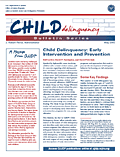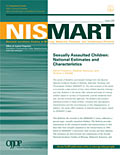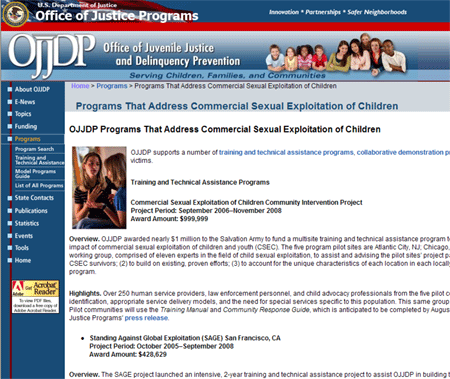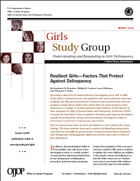
 As my tenure at OJJDP draws to a close, I wanted to take the opportunity to reflect on the accomplishments of the Office since I began as Administrator in April 2002. A leader is only as good as his team and, first and foremost, I want to thank the dedicated men and women in OJJDP and all of our partners in the field for their hard work and commitment to improving the lives of youth in this country.
As my tenure at OJJDP draws to a close, I wanted to take the opportunity to reflect on the accomplishments of the Office since I began as Administrator in April 2002. A leader is only as good as his team and, first and foremost, I want to thank the dedicated men and women in OJJDP and all of our partners in the field for their hard work and commitment to improving the lives of youth in this country.
These past 6½ years with OJJDP have been both challenging and rewarding. Together we have made outstanding achievements in the field of juvenile justice and improved conditions for the children of this country. We have made progress in difficult areas such as reducing youth gang activity, improving child safety, building new tools to enable States to make significant reductions in disproportionate minority contact, fulfilling trust responsibilities with tribal communities, and increased partnerships and collaboration between Federal agencies in addressing the needs of youth who often receive services from multiple social service providers across multiple sectors.
Faith-based and small community organizations play an important role in everything from mentoring youth in detention to helping gang-involved youth. My efforts to reach out to this extensive resource and include them in our mission have yielded great dividends. Their work demonstrates the power we can harness from people who live and work in the communities where need is greatest. We need every hand at the tasks before us and this work demonstrates that these partners can add invaluable aid that should be continued in years to come.
While challenges lie ahead, we can and should recognize where we have succeeded and work to expand and export those programs and practices that have demonstrated positive results. In that same way, we must also be willing to abandon those efforts that are not successful.
Overall, OJJDP's efforts remained focused on the goals of the Office in a period of change, by addressing new challenges—from youth gangs to child prostitution—in ways that advanced the basic responsibilities of the Office. What follows is a brief chronology highlighting our accomplishments. As our time together draws to a close, I hope you are as proud of these achievements as I am.
 Study Group on Very Young Offenders
Study Group on Very Young Offenders
The Study Group on Very Young Offenders was formed in 2001 to examine the prevalence and frequency of very young offending, how such offenders are handled by the juvenile justice systems, the services available to them, and what solutions exist. The Study Group's final report was completed in 2001 and the findings were published in the Child Delinquency Series of Bulletins including Child Delinquency: Early Intervention and Prevention; Risk and Protective Factors of Child Delinquency; Treatment, Services, and Intervention Programs for Child Delinquents; and Prevalence and Development of Child Delinquency.
Outreach to Faith-Based Groups
Beginning in fiscal year (FY) 2002, OJJDP has made a concerted effort to reach out to faith-based groups, which historically had not been a part of the Office's activities. OJJDP expanded its electronic and print mail lists to include more faith-based organizations, thus making these organizations more aware of opportunities for funding. In November 2001, OJJDP published a fact sheet about faith-based programs, Public/Private Ventures' Evaluation of Faith-Based Programs, that describes a research and demonstration effort to involve faith-based institutions as the anchoring organizations within local partnerships designed to address the developmental needs of high-risk juveniles. OJJDP has incorporated language in all of its solicitations for grant applications encouraging State and local units of government to consider faith-based and community organizations for subgrant funding and inviting faith-based organizations to apply for funding or to seek membership in local partnerships or coalitions, where appropriate. Since 2005, OJJDP has sponsored and supported several training conferences to guide faith-based groups through the Federal grantmaking process and build their organizational capacity. OJJDP continues to encourage existing grantees to recognize the role that faith-based organizations can play in community prevention efforts. For more information, please check OJJDP's Web page on faith-based and community initiatives.
 National Incidence Studies of Missing, Abducted, Runaway, and Thrownaway Children
National Incidence Studies of Missing, Abducted, Runaway, and Thrownaway Children
The Second National Incidence Studies of Missing, Abducted, Runaway, and Thrownaway Children (NISMART-2) offered major findings on how and why children become missing. OJJDP released these important findings at the White House Conference on Missing, Exploited, and Runaway Children in October 2002. The findings provide national estimates of missing children based on surveys of households, juvenile residential facilities, and law enforcement agencies. The study also presents statistical profiles of these children, including their demographic characteristics and the circumstances of their disappearances. The final two Bulletins in the NISMART series were published in 2008: Sexually Assaulted Children: National Estimates and Characteristics, Caretaker Satisfaction With Law Enforcement Response to Missing Children, and Runaway/Thrownaway Children: National Estimates and Characteristics. Please check the National Criminal Justice Reference Service Web site for the full listing of NISMART publications.
Gang Reduction Program
In FY 2003, OJJDP began its signature Gang Reduction Program (GRP) to significantly decrease youth gang activity in four neighborhoods across the country: Los Angeles, CA, North Miami Beach, FL, Milwaukee, WI, and Richmond, VA. Based on 15 years of research and testing of OJJDP's Comprehensive Gang Model, the program helps these communities combine local, State, and Federal resources to develop and implement plans to address the full range of personal, family, and community factors that contribute to high levels of juvenile delinquency and gang activity. Initial evaluations of the program are showing positive results, with significant reductions in crime and gang-related activity in Los Angeles. In addition to reducing youth gang activity, the program improved communities in other ways. For example, the GRP effort in Richmond has led to large-scale improvements and investments in the physical condition of public housing. GRP continues today in Los Angeles, North Miami Beach, and Richmond. In addition to GRP, OJJDP published Best Practices To Address Community Gang Problems: OJJDP's Comprehensive Gang Model. This publication provides communities with critical information to guide their gang prevention efforts and describes the research that produced OJJDP's Comprehensive Gang Model. The publication also presents essential findings from evaluations of several programs demonstrating the model in a variety of environments. Best Practices is available through the publications section of OJJDP's Web site. (For additional information on GRP, please see "Evaluation of OJJDP's Gang Reduction Program Yields Positive Results" in this month's newsletter.) For more information about DOJ and OJJDP anti-gang activities, please visit OJJDP's youth gang prevention Web page.
Commercial Sexual Exploitation of Children Initiatives
The Office furthered efforts to better understand commercial sexual exploitation of children (CSEC) and improve community prevention and response. In FY 2003, OJJDP chose Atlanta, GA, and New York City as pilot sites for a 5-year initiative to develop a set of model prevention strategies and practices for addressing CSEC. Atlanta is focusing on intervention and service delivery strategies that divert victims from the pimps exploiting them. New York is focusing on developing partnerships between police and social service agencies and innovative prosecution strategies for use by district attorney offices. The Atlanta test site is finished and the New York City site will complete its work in June 2009. For more information about OJJDP's CSEC efforts, please check the CSEC Web page.

Conditions of Confinement
OJJDP continued its leadership role in advancing work on conditions of confinement to ensure that the physical conditions and services of facilities that hold juveniles conform to national standards. Central to these efforts is OJJDP's support of Performance-based Standards (PbS) for Youth Correction and Detention Facilities, which was launched by the Office in 1995 in response to deplorable conditions reported in a 1994 study of secure facilities. PbS helps agencies and facilities identify, monitor, and improve conditions and treatment services provided to incarcerated youth using national standards and outcome measures. The program was one of five recipients of the 2004 Innovations in American Government Award from Harvard University and the Council for Excellence in Government. Due in large part to OJJDP's investment in the program, the PbS framework of national standards is now implemented in a majority of States. OJJDP continues to provide training and technical assistance to the States through regular events held throughout the year. In January 2007 and again in October 2008, the Office held intensive training on compliance monitoring issues, which addressed conditions of confinement. OJJDP also supports a longitudinal study of alcohol, drug, and mental disorders among juvenile detainees. Funded annually since the mid 1990s, the study is providing important insights on how to address the needs of detained youth—the majority of whom suffer from one or more psychiatric disorders—which may be critical to breaking the cycle of recidivism. OJJDP published two bulletins reporting findings from this study in 2006. OJJDP is also funding three data collections to describe both the youth placed in residential facilities and the environments of these facilities: the Census of Juveniles in Residential Placement, which provides detailed information on all juveniles in residential facilities in the United States; the Juvenile Residential Facility Census, which collects information on how facilities operate and the services they provide; and the Survey of Youth in Residential Placement, a new and unique collection that gathers information directly from youth in custody in the juvenile justice system through anonymous interviews. OJJDP began publishing a bulletin series in 2008 to highlight the first national Survey of Youth in Residential Placement.
Model Programs Guide
In response to requests for information concerning effective programs that deliver strong outcomes, the Office has expanded the Model Programs Guide (MPG) over the years to profile more than 175 prevention and intervention programs and help communities identify those that best suit their needs. Originally developed in FY 2003 as a tool to support the Title V Community Prevention Grants Program, users can now search the Guide's database by program category, target population, risk and protective factors, effectiveness rating, and other parameters to select evidence-based strategies to improve their communities. Recently, OJJDP added the DMC Reduction Best Practices Database to MPG, which is designed to assist jurisdictions in the development of effective initiatives to reduce disproportionate minority contact (DMC) with the juvenile justice system. For more information, please check the Model Programs Guide.
Disproportionate Minority Contact
OJJDP continued to focus its efforts on reducing disproportionate minority contact (DMC) with the juvenile justice system. During the past 6 years, OJJDP has developed and funded many initiatives to reduce DMC, including annual national conferences, training and technical assistance sessions, research, and publications. The Office also has funded organizations developing research, training, and other resources to address DMC. Prevention—reducing of the number of youth entering the juvenile justice system in the first place—has been a primary emphasis of all these activities. Training efforts have included 1-day sessions designed to assist States with DMC-implementation efforts, sessions for new DMC coordinators, and training for more experienced coordinators. In 2003, OJJDP introduced the DMC Relative Rate Index (RRI), which was developed and recommended by researchers convened by OJJDP as a means for jurisdictions to identify where DMC may exist within its juvenile justice system. In 2002, OJJDP published the Disproportionate Minority Confinement: A Review of Research Literature From 1989 Through 2001, and in 2004 published Disproportionate Minority Confinement: 2002 Update. OJJDP's online resources have included the Disproportionate Minority Contact Technical Assistance Manual, third edition, released in 2006 to provide States and localities guidance and tools for understanding and effectively addressing minority overrepresentation; the Web-based DMC Data Entry System, which was launched in 2006 to provide access to State and local data across the country; and the DMC Reduction Best Practices Database, an integral part of OJJDP's Model Programs Guide, which was unveiled at the annual DMC conference in October 2007. For more on OJJDP's efforts to reduce DMC, please visit OJJDP's DMC Web page.
 Girls Study Group
Girls Study Group
OJJDP convened the Girls Study Group (GSG) in FY 2004 following a surge in female arrest rates during the 1990s, to gain a better understanding of girls' delinquency and guide policy toward female juvenile offenders. Very little research had been conducted on girls' delinquency since boys had previously accounted for the majority of arrests and, therefore, the majority of research efforts. The study group sought to identify both factors for delinquency and solutions to resolve it. Initial research findings determined the higher arrest rates were due primarily to changes in arrest policies that affected both boys and girls. GSG began to release its findings in the spring of 2008 through a series of seven Bulletins. Violence by Teenage Girls: Trends and Contexts was released first, followed by Charting the Way to Delinquency Prevention for Girls in October 2008 and Resilient Girls: Factors That Protect Against Delinquency in early 2009. For more information, please visit OJJDP's Girls' Delinquency Web page.
SMART System
Since 2005, OJJDP has been developing the Socioeconomic Mapping and Resource Topography (SMART) system in cooperation with other Federal agencies and partners. This Web-based mapping application illustrates specific geographic areas of crime and delinquency and the nearby governmental and community resources that are available to prevent and control it. The system contains crime data, census data, and locations of community resources, including YMCAs, Boys and Girls Clubs, and police stations. In addition to maps, SMART creates tables and graphs to illustrate data on socioeconomic factors such as housing, population, crime, health, and mortality. As of FY 2008, OJJDP required the use of SMART in all funding solicitations. OJJDP continues to make enhancements to the SMART system to improve its utility to the field. For more information about SMART, please see OJJDP's Web site.
Coordinating Council on Juvenile Justice and Delinquency Prevention
OJJDP continued to enhance interagency collaboration and coordination through the Coordinating Council on Juvenile Justice and Delinquency Prevention (Council). The increases in the number of interagency collaborations on juvenile justice issues from year to year are a testament to the Council's progress. The Council has increased knowledge, dissemination, and use of evidence-based programs in juvenile justice and has elevated the importance of a comprehensive juvenile justice agenda at the Federal level. A notable achievement of the Council was its first-ever national conference, held in January 2006 in Washington, DC, which drew more than 2,000 attendees. Supported by OJJDP, the 3½-day conference featured more than 130 hours of workshops, addressing topics ranging from the educational needs of youth in the juvenile justice system to research on the possible links between childhood maltreatment and later delinquency. An unprecedented number of Federal agencies with youth programs highlighted their programs at the conference. For more information on the Coordinating Council and the national conference, please check the Council's Web site and the national conference Web page.
Internet Crimes Against Children Task Force Program
An integral component of the Department's Project Safe Childhood initiative, OJJDP's Internet Crimes Against Children (ICAC) task force program supports law enforcement's efforts to prevent, investigate, and prosecute computer-facilitated child sexual exploitation. In FY 2007, OJJDP awarded more than $3 million to State and local law enforcement agencies to form 13 new ICAC task forces in their regions. With these grants, there are ICAC task forces in all 50 States and a total of 59 ICAC task forces nationwide. Also in FY 2008, ICAC investigations led to more than 3,047 arrests and 13,800 forensics examinations. For more information about the ICAC task force program, please visit the Web site.
 Helping America's Youth Initiative
Helping America's Youth Initiative
OJJDP participated in the Helping America's Youth (HAY) initiative, a White House-led effort to assist at-risk children and teenagers to reach their full potential. OJJDP and other Federal agencies and White House offices developed and managed the HAY Web site and the Community Guide to Helping America's Youth. This online resource helps communities identify the challenges their youth face and how they can overcome these challenges. The Guide describes how communities can build strong supports for youth, build partnerships, assess needs and resources, and select program designs they can replicate in their communities. OJJDP continues to play a key role in the next steps of the HAY initiative as a new Web portal of youth information is developed and launched. Planned for launch in 2009, the online portal builds on the Guide and will provide strategies and tools to help promote effective community-based efforts to reduce the factors that put youth at risk and provide high-quality services to at-risk youth across the country. For more information, please visit the HAY Web site.
Indian Country
OJJDP has engaged in a range of efforts to strengthen juvenile justice systems and protect children in Indian country. In 2004, OJJDP convened a Tribal Leaders Listening Conference to foster collaboration between tribes and the Federal Government on a range of issues affecting tribal youth, including justice, education, prevention and intervention, teen pregnancy, substance abuse, and child abuse. Tribal leaders from 13 regions met with representatives from the Departments of Justice, Education, Health and Human Services and the Interior. OJJDP also focused on the specific needs of Indian country in a 2005 meeting of the Federal Advisory Committee on Juvenile Justice held in New Mexico, which has the highest percentage of American Indians of any Federal jurisdiction. The meeting included presentations on a range of local prevention and education programs addressing juvenile crime, gangs, substance abuse, truancy, and other issues affecting tribal youth. OJJDP has made a major investment in mentoring in Indian country, awarding $4 million in FY 2008 to strengthen and expand mentoring activities for at-risk youth in tribal communities. OJJDP has also led efforts to protect children in Indian country through its support of the AMBER Alert program, which coordinates media broadcasts on radio, television, and highway signs when a law enforcement agency determines that a child has been abducted and is in imminent danger. Through an expansion of this initiative to Indian country, 13 tribal communities have developed AMBER Alert plans. These sites are working to provide tribal children the same degree of protection afforded to other children across the country via the State and regional AMBER Alert programs. For more information about OJJDP's efforts on behalf of tribal youth, visit OJJDP's Tribal Youth Program Web page. Please visit the AMBER Alert Web site for more information.
 Project Safe Childhood National Awareness Media Campaign
Project Safe Childhood National Awareness Media Campaign
In November 2008, OJJDP spearheaded efforts to launch a national awareness media campaign about online child sexual predators through the Department's Project Safe Childhood initiative. The goal of the media campaign, which featured English and Spanish television and radio ads, Internet banners and pop-ups, and movie theatre PSAs, was twofold: 1) to educate parents about the need to supervise their children's online activities, and 2) to warn would-be predators about the consequences of using the Internet to entice minors into illegal sexual activity. While other campaigns have promoted awareness to parents in the past, this was the first time would-be predators were targeted for deterrence. A national launch event was held in Washington, DC, followed by regional events in St. Louis, San Diego, Seattle, and Miami. For more information about the PSC media campaign, please visit OJJDP's portal Web page.
The Urban Institute is finalizing an evaluation that examines GRP for the initial pilot period of spring 2003 to mid-to-late 2007 in four areas with reported gang activity: Los Angeles, CA; North Miami Beach, FL; Milwaukee, WI; and Richmond, VA. OJJDP awarded each site $2.5 million to implement the model. All of the program sites are still in operation except for Milwaukee.
Evaluators deduce that the GRP was more successful in Los Angeles because the service providers and neighborhood partners in the target area already were committed to addressing gang and violent crime issues. Plus, many of the partners had previously collaborated to address the gang issues, and the Los Angeles Police Department had an established gang-suppression effort that was expanded to the GRP area.
In Richmond, decreases in violent crime activity were recorded despite an initial crime increase that began at the program's initiation. The implementation of the plan involved the mobilization and cooperation of over 50 faith-based and community-based programs. Additional police patrols were added which contributed to a significant decrease in crime during the pilot period. During the funded period, Richmond dropped from the 5th most dangerous city in the Nation to the 15th, and is now ranked as the 29th.
One of the study's chief findings is that GRP's success relied on the site coordinator's leadership abilities. According to the report, there was a considerable amount of friction between committee members during the initial stages before the funding was awarded. However, collaboration improved at each test site as the program continued.
Each area was evaluated for its specific needs and then implementation plans were developed from those assessments. The implementation plan responded to the area's specific needs through a series of partnerships and collaborations of services. Each plan is site specific, and, therefore, the results are site specific also.
The Comprehensive Gang Model is outlined in the OJJDP publication Best Practices
To Address Community Gang Problems: OJJDP's Comprehensive Gang Model, which was released in June 2008. (For more information on Best Practices, please see "New Publications" in the July/August 2008 edition of News @ a Glance.
The final evaluation report is due to OJJDP in January 2009 from the Urban Institute. OJJDP is also producing a Bulletin for release in early 2009 to highlight the evaluation findings.
 On the Rocky Boy's Indian Reservation in rural Montana, the Chippewa Cree Tribe is fighting underage drinking through the innovative Healing to Wellness Program, thanks to an OJJDP Tribal Juvenile Accountability Discretionary Grants (T–JADG) program award. The Healing to Wellness Program uses the same basic strategies used by other juvenile drug courts in nontribal communities.
On the Rocky Boy's Indian Reservation in rural Montana, the Chippewa Cree Tribe is fighting underage drinking through the innovative Healing to Wellness Program, thanks to an OJJDP Tribal Juvenile Accountability Discretionary Grants (T–JADG) program award. The Healing to Wellness Program uses the same basic strategies used by other juvenile drug courts in nontribal communities.
The Healing to Wellness Program helps juveniles recognize and take steps to overcome their drinking problems through evaluations, individual treatment plans, and cultural activities designed to build self-esteem. The 9-month program partners with a network of agencies that sponsor youth programs that address substance abuse and foster healthy lifestyles. The program provides incentives to motivate tribal youth to turn their lives around: court sentences are deferred while the youth participate in the program; if juveniles complete the program, prosecution is deferred.
The program consists of four phases with built-in accountability. The first phase includes clinical treatment, weekly court appearances, random drug and alcohol tests, and community service. Youth must be enrolled in school and participate in cultural awareness activities. The second phase emphasizes personal responsibility; juveniles must continue to meet a curfew, visit with a juvenile court counselor, and participate in drug and alcohol education. In the third phase, the young people begin assessing and applying what they have learned by mentoring other youth in the program and participating in other activities. During the final phase, adolescents are taught to recognize the signs of relapse, and the number of treatment sessions and random drug and alcohol tests is reduced.
The tribe recently expanded the program to include working with parents, providing education and information that fosters the health and well-being of the entire family. The goal is to ensure that tribal youth grow up in an environment that predisposes them to success and a healthy way of living.
For more information about the tribal youth programs, please visit OJJDP's Web site.
OJJDP's Demonstration Programs Division is holding a New Grant Recipient Orientation Training for all new grantees January 26–28 in Washington, DC. The training will familiarize grant recipients with OJJDP and provide attendees the information and resources they need to manage their grants more effectively. The 2½-day session will offer participants direct access to OJJDP grant managers who will be available to answer questions and work with attendees throughout the training sessions. Agenda items include performance measurement, reporting requirements, program development, financial monitoring, working with grant managers, networking, and funding/training opportunities.
Comprehensive Gang Model Training
OJJDP is offering a 3-day intensive training in March 2009 for communities interested in implementing the OJJDP Comprehensive Gang Model. The training will require communities with significant youth gang issues to bring multidisciplinary teams together to learn how to implement the various strategies of this research-based and proven effective model. National experts from around the country will provide participants with intensive training and technical assistance to deal with their unique gang issues. Attendance at the workshop is by invitation only and limited to 100 participants. Dates and location of the workshop will be set and announced at a later date. Interested communities should request youth gang technical assistance through OJJDP's National Youth Gang Center Web site.
New Online
 Juvenile Residential Facility Census, 2004
The biannual Juvenile Residential Facility Census (JRFC) collects information about the facilities in which juvenile offenders are held. Facilities report on characteristics such as their size, structure, type, ownership, and security arrangements. Information on the range of services they provide to youth is also reported. In 2004, JRFC focused on educational and physical health services. In addition, facilities report on the number of deaths of youth in custody during the prior 12 months. Findings reported in this Bulletin show that the population of juvenile offenders in custody continued to decline—down 7 percent from 2002—and that, in 2004, 5 percent of facilities (holding 15 percent of juvenile offenders in custody) exceeded their standard bed capacity or had juveniles sleeping in makeshift beds. To read or download Juvenile Residential Facility Census, 2004, please visit the NCJRS Web site.
Juvenile Residential Facility Census, 2004
The biannual Juvenile Residential Facility Census (JRFC) collects information about the facilities in which juvenile offenders are held. Facilities report on characteristics such as their size, structure, type, ownership, and security arrangements. Information on the range of services they provide to youth is also reported. In 2004, JRFC focused on educational and physical health services. In addition, facilities report on the number of deaths of youth in custody during the prior 12 months. Findings reported in this Bulletin show that the population of juvenile offenders in custody continued to decline—down 7 percent from 2002—and that, in 2004, 5 percent of facilities (holding 15 percent of juvenile offenders in custody) exceeded their standard bed capacity or had juveniles sleeping in makeshift beds. To read or download Juvenile Residential Facility Census, 2004, please visit the NCJRS Web site.
 Girls Study Group: Resilient Girls—Factors That Protect Against Delinquency
Girls Study Group: Resilient Girls—Factors That Protect Against Delinquency
This Bulletin examines factors that research suggests may protect girls who are at risk of becoming delinquent. The third publication in OJJDP's Girls Study Group series, this Bulletin establishes a theoretical and empirical foundation to guide the development, testing, and dissemination of strategies to reduce or prevent girls' involvement in delinquency and violence. The Bulletin explores four hypothetical processes that may operate as protective factors in the lives of girls at risk for delinquency—support from/presence of a caring adult, school connectedness, school success, and religiosity. To read or download Resilient Girls—Factors That Protect Against Delinquency, please visit the NCJRS Web site.
Coming Soon
Toolkit for Court Performance Measures in Child Abuse and Neglect Cases

The Toolkit for Court Performance Measures in Child Abuse and Neglect Cases provides practical and comprehensive guidance on how dependency courts can institute a system of performance measurement and create more efficient and effective operations. The result of a collaborative, broad-based effort between the Children's Bureau of the Department of Health and Human Services and OJJDP, the Toolkit provides practical, comprehensive guidance on how to undertake performance measurement to improve child and family outcomes of safety, permanence, and well-being and move toward more efficient and effective dependency court operations. Three leading court reform organizations—the American Bar Association, the National Center for State Courts, and the National Council of Juvenile and Family Court Judges—provided technical support, and 12 pilot sites in which the Toolkit was tested also provided critical feedback and input. The Toolkit is designed to help courts:
- Establish their baseline of current practices.
- Diagnose what areas of service delivery they need to improve.
- Make improvements to their operations.
- Track their efforts.
- Identify, document, and replicate positive results.
This publication is divided into five volumes:
Key Measures (NCJ 223567). This 44-page booklet outlines nine measures that OJJDP, the Children's Bureau, and their national partners have identified as key to determining court performance in child abuse and neglect cases. The booklet discusses the goal of each measure, data requirements, calculation and interpretation, and important related measures.
Implementation Guide (NCJ 223568). This 76-page guide provides practical advice on how to set up a performance measurement team, assess court capacity, collect data, and use the data to plan reforms.
User's Guide to Nonautomated Data Collection (NCJ 223569). This 48-page guide provides instructions on how to use instruments to measure court performance. Each chapter is devoted to a specific instrument and describes the purpose of the instrument, provides tips on how to use it, and explains how the data can be used to assess court performance on a national level.
Technical Guide (NCJ 223570). This comprehensive 310-page volume describes all 30 court performance measures for child abuse and neglect cases.
Guide to Judicial Workload Assessment (NCJ 223571). This 72-page guide is designed to help courts establish their baseline practices; diagnose what they need to improve; and use that information to make improvements, track their efforts, and identify, document, and replicate positive results.
This publication series may be ordered in its entirety or as individual publications. The Toolkit will be available online in mid to late January. Printed copies may be ordered at www.ojjdp.ncjrs.gov/publications/courttoolkit.html.
 The Coordinating Council on Juvenile Justice and Delinquency Prevention (Council) held its winter Quarterly Meeting on December 5, 2008. Agenda items included the launch of the comprehensive community initiatives toolkit and an update on research on religiosity and prosocial youth behavior. The meeting minutes will be available through the Council's Web site at a later date.
The Coordinating Council on Juvenile Justice and Delinquency Prevention (Council) held its winter Quarterly Meeting on December 5, 2008. Agenda items included the launch of the comprehensive community initiatives toolkit and an update on research on religiosity and prosocial youth behavior. The meeting minutes will be available through the Council's Web site at a later date.
The spring quarterly meeting will be held on Friday, March 6, 2009. Additional information will be posted to the Council's Web site as it becomes available.
For more information on the Council please visit the Web site.
The Council is comprised of 18 members, including 9 ex officio members—the Attorney General, the Secretaries of the Departments of Justice, Education, Health and Human Services, Housing and Urban Development, and Labor; the Assistant Secretary of Immigration and Customs Enforcement in the Department of Homeland Security, the Director of the Office of National Drug Control Policy; and the Chief Executive Officer of the Corporation for National and Community Service. An additional nine members are juvenile justice practitioners appointed by the Speaker of the House of Representatives, the Senate Majority Leader, and the President of the United States.
 The Federal Advisory Committee on Juvenile Justice (FACJJ) fall meeting was held October 19–21, 2008, in San Diego. Meeting agenda items included an update on the drafting of the 2009 annual report, working group reports, and a presentation on developing disproportionate minority contact (DMC) action plans. For more information on the fall 2008 meeting, please check the meeting minutes online at the FACJJ Web site. Plans for the spring 2009 meeting will be announced at a later date.
The Federal Advisory Committee on Juvenile Justice (FACJJ) fall meeting was held October 19–21, 2008, in San Diego. Meeting agenda items included an update on the drafting of the 2009 annual report, working group reports, and a presentation on developing disproportionate minority contact (DMC) action plans. For more information on the fall 2008 meeting, please check the meeting minutes online at the FACJJ Web site. Plans for the spring 2009 meeting will be announced at a later date.
FACJJ meetings are public and anyone may register to attend and observe. For additional information, including information on future and past meetings and annual reports from fiscal year 2004 to 2007, visit FACJJ's Meetings Web page.